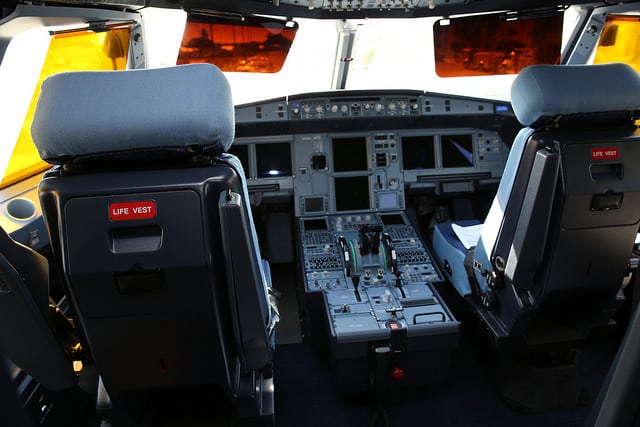
Hawaiian Airlines Airbus A321neo cockpit. Photo courtesy of Hawaiian Airlines
January will bring a new beginning to Hawaii, when Hawaiian Airlines begins flying its first Airbus A321neo. Hawaiian CEO Mark Dunkerly, who will retire in March, sees the A321neo as the airline’s new “competitive weapon” for flights to destinations on the West Coast of the U.S.
Hawaiian will begin operating the A321neo with its first commercial flight Jan. 8, as the first of 18 re-engined A321s enters its commercial fleet. During Hawaiian’s recent annual investor day, Dunkerly and other Hawaiian executives outlined their future vision for how the A321 could improve its competitiveness in the U.S. domestic market.
“The neo is the competitive weapon of choice for the midsize Hawaii-to-West-Coast market, and they open the door to our ability to compete in that last piece of the U.S. domestic market that we have left [open] for want of the right equipment,” said Dunkerly. “On both the cost and revenue sides of the equation, Hawaiian is going to be better positioned than any present or future competitors as a result.”
Airbus completed the first delivery of the A321neo to Hawaiian in April 2017. The French airplane manufacturer describes the revamped A321 as featuring a maximum capacity of 240 passengers, with a range of up to 500 additional nm compared to the current engine option version of the A321. New engine options include Pratt & Whitney’s PW1100G-JM and CFM International’s Leap-1A. Hawaiian selected the Pratt & Whitney engine for its fleet of A321s.
Hawaiian’s A321neo cockpit features Rockwell Collins avionics, including a digital low-range altimeter, ADS-B-compliant transponders and new multi-mode receivers. The neo fleet being delivered to Hawaiian will also feature the avionics maker’s MultiScan ThreatTrack weather radar technology, which was upgraded with new features and approved as an aftermarket upgrade for A330s and A320s in October 2016.
While the A321neo will be the latest aircraft to join Hawaiian’s fleet, the carrier has also been an industry leader in recent years in equipping with new avionics equipment designed to reduce its reliance on ACARS technology. The airline is also flying with a unique aircraft-to-dispatch and aircraft-to-aircraft communications technology produced by WxOps.
During the recent investor day presentations, Peter Ingram, executive VP and chief commercial officer for Hawaiian, also explained why the airline believes the A321neo is the most economical aircraft for its routes to destinations on the U.S. West Coast. The carrier has three specific mission sets: inter-island flying using re-configured Boeing 717s, as well as flights to the West Coast and internationally using A330s.
Ingram said in the future, Hawaiian wants to reduce the number of hours flown to the West Coast using its A330s and replace the majority of those flights with the A321neo.
“From a fleet perspective, airplanes tend to either be really perfect for us or not very useful at all. We’re fortunate we’ve been able to position our fleet now in a way to ideally serve each of those different missions,” said Ingram.
“The 321 is really the ultimate airplane for what we’re doing flying to the West Coast, ultra efficient flying 2,500-mile missions that make up so much of our network,” he added. “Usually when you go to a smaller gauge airplane, you sacrifice seat-mile economics. That is not the case with this new generation of airplanes. We can get unit costs that equal, or rival, a wide body with a smaller gauge — 189 seats, and that’s going to be what opens up those midsize [origins and destinations] for us.”
The Hawaiian executives did not discuss, however, whether they will consider adding in-flight internet to the A321neo or to any aircraft within its fleet. Currently the airline provides in-flight entertainment tablets for passengers and in-seat power outlets for portable devices, but no access to the internet in the cabin.
According to Dunkerly, Hawaiian will also look to retire the last of its Boeing 767s by the end of 2018.